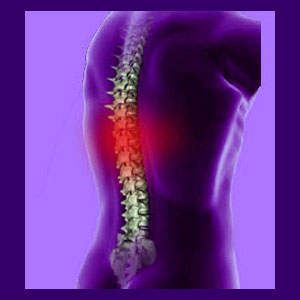
Middle back pain symptoms are not the most common type of dorsopathy syndromes, but for patients who suffer from them, life can be a real trial. Mid back symptoms can be agonizing and debilitating, often limiting use of the arms. The middle back is generally resistant to injury and immune from the usual spinal degenerative processes which take hefty tolls on the lumbar and cervical spinal regions. The middle back is less likely to be damaged in a traumatic event but this is certainly not an absolute rule. Fortunately, most cases of mid back pain are muscular in nature and will heal without any special medical care whatsoever.
This investigative essay explores a diversity of mid thoracic pain symptoms. We will discuss typical and atypical symptomatic expressions, as well as their relevance to affected patients. If you need to learn about middle back pain, this is the right article for you.
Location of Middle Back Pain Symptoms
Patients generally report middle back pain on one side or the other. The most common area affected is slightly off the spine, by about 2 inches or so. Unilateral pain affects the vast majority of patients who report symptoms off the spine, with only about 5% citing being victimized by bilateral symptoms. Off-center pain is generally found to affect a larger area and a less specific area than central spinal pain. In essence it may be found anywhere in the middle thoracic region or throughout the whole middle back area.
The next most common location for pain is directly over the spine. This pain is often linked to posture, position or movement. Spinal-centered pain is usually more focused by location and smaller in affected area. Most patients can pinpoint exactly where the symptoms occur, which often proves helpful during diagnostic evaluation.
Many patients get pain in between the shoulders or just below the shoulder blade, which may be linked to movement of the arm or arms. Other patients report that their pain is directly linked to movement of their neck, with citations of painful rotation, flexion and/or extension being commonplace.
Torturous Symptoms of Middle Back Pain
The middle back is made for durability, structure and protection. It is generally not called upon to bend and flex as often or as far as the lower back or neck, so the spinal structures in the thoracic levels do not demonstrate the same types of degenerative concerns which affect these more mobile regions of the back. The incidence of disc disease, bulging discs and osteoarthritis is much lower in the mid thoracic spine, so it is no surprise that facet syndrome, neuroforaminal stenosis and spinal stenosis are also seldom seen. However, the muscular anatomy in the area is complex and involves many tissues working together to provide movement. Injury to one or more of these tissues can cause truly agonizing, physically limiting and widespread pain regionally.
When injury befalls the mid thoracic spine, the lack of regional mobility may just be one of the main factors leading to significant injury. The ribs can prevent the spine from moving in compensation to injurious force, forcing it to absorb more stress. Trauma can create damage to the spinal cord, spinal nerves, vertebral bones, intervertebral discs, supporting musculature or connective tissues in the region. Similarly, injury can also occur to the areas where the ribs tie into the spine, often creating pain when breathing, moving in particular ways or in certain positions. Regardless of the cause of pain, it is vital to remember that:
Injuries will heal. Healing is the body’s main imperative.
Muscular back pain issues should not be chronic if they are from injury or occasional overuse. True RSI problems might become persistent pain problems and may require lifestyle changes or professional intervention to resolve.
Long-term and treatment-resistant symptoms may be caused by an ischemic back pain syndrome, even when incidental structural scapegoats might be present. Be certain to question, test and verify any diagnostic theory before proceeding into treatment for best results.
Treatment for Middle Back Pain Symptoms
Successful treatment of any painful event relies on accurate diagnosis. Most mid back pain is due to muscular overuse or minor injury, commonly known as back sprain or back strain. These types of symptomatic conditions can be miserable to endure, but usually resolve in a few days to a few weeks, even without any treatment. Pain due to a spinal issue is rare in the middle back, unless major trauma has been endured. In these cases of serious injury, the middle back vertebrae or intervertebral discs may be affected and pain can be difficult to pin down to a specific location in some instances.
Just remember that many instances of back pain are idiopathic and may be linked to stress or other psychogenic mechanisms. When pain endures well past its clinical expectation, or is more severe than possible structural explanations can account for, the chance of symptoms being linked to the mindbody process increase exponentially. Keep this in mind if your middle back pain symptoms defy the healing effects of both time and treatment.





